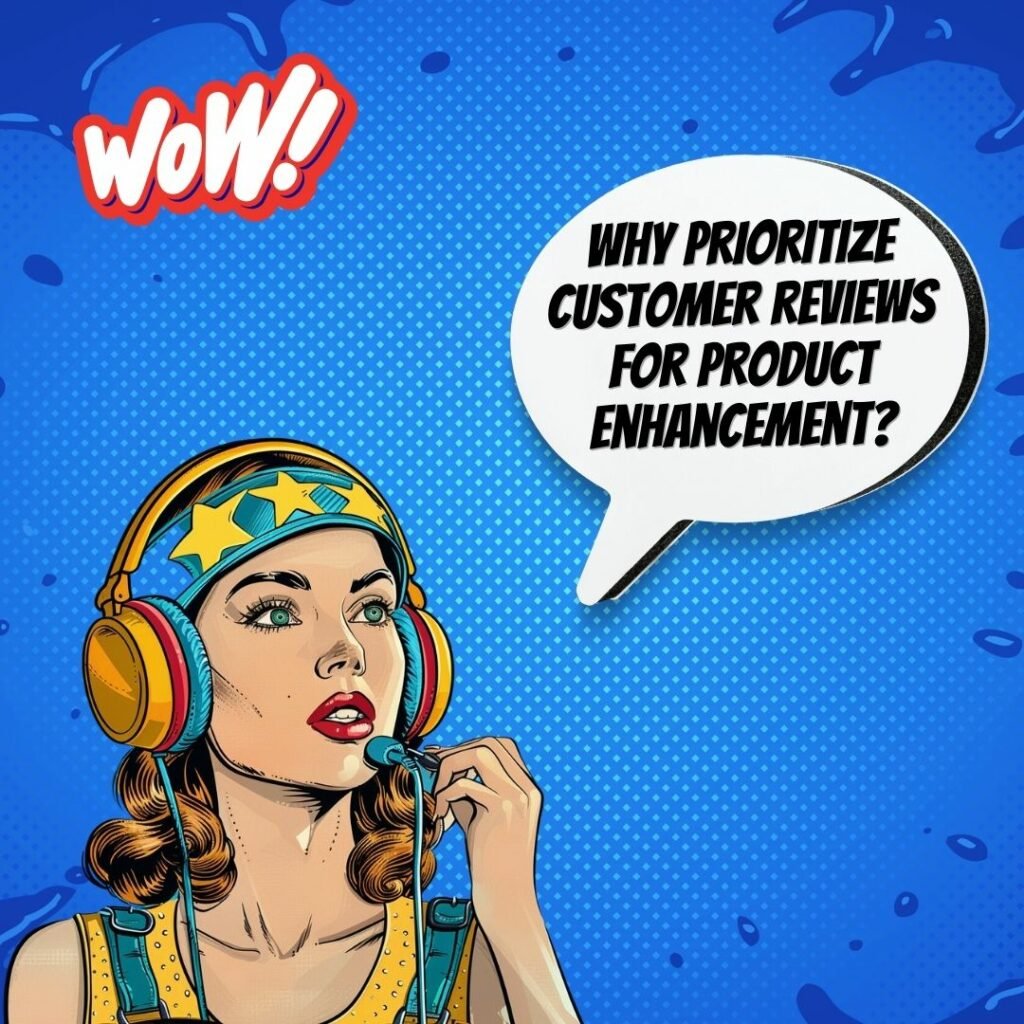Key Takeaways
✅ Gather Feedback Through Various Channels: Broaden your reach by employing multiple feedback mechanisms like surveys, customer support interactions, and reviews. Diverse touchpoints such as email, chat, and in-app messages can yield rich insights from a wider audience. Did you know that, according to a Salesforce report, 74% of people are likely to switch brands if they find the purchasing process too difficult? Simplify your channels for easy customer input.
✅ Analyze and Act on Feedback: Dissect the information you collect to reveal trends that can directly influence product refinement. With sentiment analysis and NPS surveys, you can turn feedback into actionable steps for product development. Consider that a Microsoft survey highlighted that 77% of consumers view brands more favorably if they proactively invite and accept customer feedback.
✅ Integrate Feedback into the Product Development Cycle: Keep your ear to the ground and your products in tune with customer desires. Adaptable strategies based on customer insights lead to improved satisfaction, loyalty, and innovation. A report by Chattermill indicates that brands that excel at customer experience have 1.5 times more engaged employees than less customer-focused companies, showing the benefits of feedback on company culture as well.

Introduction
How closely are you listening to your customers? In the bustling marketplace, the surefire way to keep your products relevant and loved is by harnessing the insights provided through Customer Feedback & Surveys. It's not just about gathering data; it's about understanding the heart of your customer's needs and desires. Did you know that, according to HubSpot, a staggering 42% of companies don't collect feedback from their customers? That's a lot of missed opportunities for improvement and growth.
In this era, where customer expectations are skyrocketing, brands that excel in product innovation based on consumer input are the ones carving out a significant niche for themselves. With this article, you'll unearth innovative ways to transform customer feedback into gold—enabling you not just to meet but exceed your clientele's most intricate expectations. We're delving into a world where every comment, every review, and every survey response holds the potential to skyrocket your product's market fit and commercial success. Stay tuned, as we're about to lift the veil on breakthrough insights and strategies that could redefine your product roadmap and ensure your offerings resound with powerful resonance in the hearts of your consumers.
Top Statistics
| Statistic | Insight |
|---|---|
| 85% of small and medium-sized enterprises say that online customer feedback has been beneficial to their business. | Customer feedback can be a gold mine of insights for businesses, especially for smaller ones that may rely on close customer relationships to grow. |
| 98% of buyers read online reviews before making a purchase decision. | Customer reviews can make or break the reputation of a product, serving as a modern word-of-mouth recommendation. |
| 91% of people believe that companies should fuel innovation by listening to buyers and customers. | This highlights the importance of incorporating customer feedback directly into the product development process. |
| 54% more revenue is generated by businesses with more reviews. | Reviews not only influence reputation but are also closely tied to a company's bottom line. |
| 83% of shoppers discover new brands and products every month through reviews. | Product reviews serve as a discovery channel, connecting potential customers with brands they may not have found otherwise. |
Collecting Customer Feedback: The First Step to Improvement
Collecting customer feedback is much like planting the seeds that will grow into your business's success. Whether it’s through surveys, online reviews, or direct conversations, you're seeking the raw materials that can spark improvement. Customers need an easy way to share their experiences, and businesses must create channels that foster open communication. An incentive, such as a discount on future purchases, might be the nudge customers need to take part. The real trick is in crafting the questions. Ask about what matters: How does the product fit into their life? What would make it better? Their answers are the blueprint for your next big step. Additionally, utilizing various feedback channels, such as social media, email campaigns, and in-store feedback stations, ensures that you capture a wide range of customer voices. Regularly collecting feedback also helps identify recurring issues quickly, allowing for timely interventions. Implementing a feedback loop where customers see the changes made based on their input encourages continued participation. Businesses that prioritize feedback collection demonstrate a commitment to customer satisfaction, which can enhance brand loyalty.
Analyzing Feedback: Identifying Trends and Opportunities
Once the feedback is collected, the detective work begins. To make sense of all the responses, businesses turn to tools and software that help sift through data. Graphs paint a visual picture, while filters and segments reveal what different groups of customers think. Are 18-to-25-year-olds raving about a feature that those over 50 are struggling with? Perhaps it's time to consider a product line that caters to different age groups. This is about connecting the dots between what you offer and what your customers need, and sometimes those needs can surprise you. Regularly reviewing feedback trends can also highlight areas for innovation and new product development. Analyzing feedback over time allows businesses to track the impact of changes and measure improvements in customer satisfaction. By identifying both positive and negative trends, companies can capitalize on strengths and address weaknesses more effectively. Incorporating feedback analysis into strategic planning ensures that customer insights are at the heart of business decisions.
Crafting Clear and Concise Questions for Actionable Insights
The art of the survey lies in its questions. You're not just chatting; you're seeking actionable insights. Straightforward, direct language will prevent misunderstandings, and a mix of yes-no and open-ended questions will give you a blend of the quantitative and the qualitative. It's like putting together a jigsaw puzzle where every piece is shaped by the words you choose - get them wrong, and the picture will never come together. Additionally, pre-testing survey questions with a small group can help refine them for clarity and effectiveness. Avoiding jargon and using language familiar to your audience ensures that responses are genuine and relevant. Including follow-up questions based on initial responses can provide deeper insights. Rotating questions periodically can keep surveys fresh and engaging for repeat respondents. Crafting well-thought-out questions ultimately leads to more reliable and actionable data.
Processing and Organizing Feedback for Maximum Impact
Now, let’s talk about organizing feedback. It's not just about reading reviews; it's about thematic categorization and trendspotting. With the right software, you can automate the dull parts, freeing you to focus on the gold nuggets of insight that can lead to change. What do customers keep mentioning? What issues crop up again and again? By identifying and acting on these points, businesses gain a competitive edge and drive towards greater customer satisfaction. Organizing feedback into categories such as product features, customer service, and pricing can streamline the analysis process. Regularly updating your feedback database ensures that all new insights are captured and considered. Visual tools like heat maps and word clouds can highlight common themes and sentiments. Collaborative tools allow teams across the organization to access and contribute to feedback analysis. This structured approach enables a more strategic response to customer needs and enhances the overall effectiveness of feedback-driven improvements.
Implementing Changes and Communicating with Customers
Taking in customer feedback is one thing; acting on it is another. Once priorities are set, it's time to implement changes. Whether it's a tweak in design or a complete overhaul, each change should be tracked meticulously. And don’t forget to tell the world! Customers love knowing their voices are heard. Keeping them in the loop builds trust and loyalty, and who doesn't want customers who feel like they're part of the family? Regular updates on implemented changes can be shared through newsletters, social media, and direct communications. Creating a feedback forum where customers can see and discuss the changes can foster a sense of community. Showcasing case studies or success stories based on customer feedback highlights your commitment to improvement. Transparent communication about the feedback process and outcomes reinforces the value you place on customer input. This continuous dialogue helps in maintaining a strong connection with your customer base.
Continuous Improvement: The Key to Success
Continuous improvement is not a one-off; it's a philosophy, a commitment. It means always having an ear to the ground, ready to listen to what your customers say. The market, much like a river, never stops moving, and neither should your efforts to improve. By making feedback analysis an ongoing process, you spot trends, make well-informed decisions, and offer products that not only meet expectations but consistently surpass them, ensuring your customers stay for the ride. Establishing a culture of continuous improvement involves regularly revisiting and refining processes. Investing in ongoing training for staff ensures they are equipped to implement feedback-driven changes effectively. Celebrating milestones and improvements publicly can motivate both employees and customers. Regularly benchmarking against industry standards helps maintain competitive advantage. Embracing continuous improvement fosters innovation and adaptability, crucial for long-term success.
AI Marketing Engineers Recommendation
Recommendation 1: Leverage Analytics to Prioritize Product Improvements: It's not just about collecting feedback; it's what you do with it. Dive into customer feedback and survey data with robust analytics tools to prioritize product enhancements. According to a report by Microsoft, 90% of consumers worldwide consider customer service when deciding whether to do business with a company. Utilize natural language processing to parse through customer reviews and survey responses to identify recurring themes and pinpoint areas for improvement. By quantifying the frequency and sentiment of feedback related to specific features or issues, businesses can better prioritize product development efforts, ensuring that they allocate resources to changes that will have the biggest impact on customer satisfaction.
Recommendation 2: Integrate Real-Time Feedback into Agile Product Development: In a landscape where 70% of companies that deliver best-in-class customer experience use customer feedback, according to Forrester, it's clear that responding swiftly to consumer needs is essential. Implement an approach that integrates real-time feedback into an agile product development process. This ensures that the voice of the customer informs every stage of the product life cycle. By constantly iterating based on up-to-date customer insights, companies can create products that not only meet but exceed customer expectations, leading to higher satisfaction and loyalty.
Recommendation 3: Employ Customer Review Platforms to Boost Credibility: Harness the power of online customer reviews, as 89% of consumers globally read reviews before buying products, according to Trustpilot. Encourage customers to leave honest reviews and make it easy for them by linking to review platforms post-purchase or after customer service interactions. Engage with reviews—both positive and negative—in a timely and constructive manner to show that you value customer input. By actively managing your reviews, you not only enhance product credibility but also glean valuable insights that can drive further improvements. Tools like Trustpilot or Yotpo can streamline this process by gathering and managing reviews across various platforms, providing detailed analytics, and integrating them into marketing and development workflows.
Relevant Links
- Maximize Your Brand's Success with WeChat: Your Comprehensive Guide to China's Digital Giant
- Unleash the Power of Douyin & Kuaishou: Catapult Your Brand in China's Short-Video Scene
- SEO Secrets Unveiled for South Korea's E-Commerce Market: Boost Traffic & Skyrocket Sales
- Navigate the Evolving Landscape of Chinese Consumer Behavior: Trends & Insights for 2024
- Dominate Google.de: Proven SEO Strategies for the German Market
Conclusion
In the journey to elevate products and secure a spot at the top of the consumer's mind, customer feedback stands as a beacon, guiding companies through the murky waters of market demand. From the collection of surveys and reviews to the meticulous analysis of feedback lies a pathway to innovative breakthroughs and strategic refinements that can set a product apart. Do consumers feel heard when they voice their opinions through reviews and surveys? Is there a visible link between their suggestions and the product changes they witness? Essential to this process is the art of inquiry – posing clear, concise questions that not only resonate with customers but also pave the way for actionable insights. Processing and organizing this feedback is more than pulling numbers; it's about understanding the story behind these numbers and transforming perceptions into enhanced products.
How can companies demonstrate their commitment to customer satisfaction? By accelerating the implementation of changes based on feedback and fostering transparent communication. This is a key element in building trust and lasting customer relationships. However, it is the philosophy of continuous improvement that remains the core driver towards sustained success. Regular feedback loops create a dynamic environment where each voice can potentially shape the future of a product. As businesses look forward, they should not just listen but actively seek out what their customers are saying. Embracing this open dialogue with consumers is not just a strategy; it's a lifeline for growth and a commitment to excellence. So, how will your business ride the next wave of customer-inspired innovation?
FAQs
Question 1: What is customer feedback?
Answer: Customer feedback is vital information shared by clients about their experience with a product or service. This insight plays a key role in guiding businesses on what's working well and what could use a bit of tweaking.
Question 2: Why is customer beneficial?
Answer: It's like having a roadmap that shows where you're going strong and where you might be veering off track. It makes people feel they're part of the journey, helps spread the word in their circles, keeps them coming back, sharpens up what you're selling, and, really, it just tightens that bond with your brand.
Question 3: How do you collect customer feedback?
Answer: Well, think of it like fishing with different kinds of nets. You can cast surveys, interviews, emails, social media, those nifty website pop-ups, reviews, chats, or various scores like NPS, CSAT, and CES to catch what customers are throwing your way.
Question 4: How do you analyze customer feedback?
Answer: It's a bit of a mixed bag. You roll up your sleeves and dive into the numbers for the clear-cut, hard facts. Then comes the detective work, sifting through the words to get the juicy details behind those facts.
Question 5: What are the benefits of product feedback?
Answer: Imagine a boost to your product that makes it irresistible because you now really get the needs and wants of your customers. It’s like giving them a VIP experience, and guess what? They stick around much longer.
Question 6: How do you use customer feedback for product development?
Answer: It's a bit like baking a cake—you've got a recipe (objectives), ingredients (feedback methods), the actual mixing (strategy implementation), taste tests (analysis and prioritization), and the final decoration (integration into product development).
Question 7: How do you create effective surveys?
Answer: Keep it simple, clear, and straight to the point. Sprinkle some tech with tools like Google Forms and SurveyMonkey, and place your surveys smartly along the customer's path.
Question 8: How do you engage with customers based on feedback?
Answer: Talk back! Show your customers their words aren't just going into the void. Weave their ideas into your plans and keep the folks at the front desk on board so everyone knows they're being listened to.
Question 9: How do you measure the success of customer feedback initiatives?
Answer: Keep tabs on how happy and faithful your customers are, bring in tools to help see the big picture or break it down by bits that make sense for your biz, like different customer types or product lines.
Academic References
- LinkedIn. (2023). How to Use Customer Feedback to Improve Your Products. In this insightful article, LinkedIn elaborates on the pivotal role of customer feedback in refining products. The methodical collection of feedback through surveys, reviews, and ratings is advocated as essential, with a focus on dissecting this information to discern trends and consider customer demographics for product enhancement.
- SurveySensum. (2024). Leverage Feedback for Product Development. This paper outlines the invaluable nature of customer feedback in product development processes. A comprehensive guide on feedback collection is provided, with emphasis on the intentional use of this feedback, driven by clear objectives, to spur innovation within the business environment.
- Deskera. Ways to Use Customer Feedback to Improve Customer Experience. Deskera addresses the myriad techniques for procuring customer feedback and the transformative power it holds in bettering customer experience. Highlighted are the advantages of such feedback, including enhancements in satisfaction, retention, and the nurturing of brand loyalty.
- Zendesk. Customer Feedback: 7 Strategies to Collect and Leverage It. This strategic guide offers seven key methodologies for capturing and applying customer feedback effectively. Emphasis is placed on the simplification of the feedback process, the diversity of channels for feedback collection, and the recognition and celebration of improvements, all aimed at cultivating lasting customer relationships.
- Qualaroo. (2024). How to Use Customer Feedback for Product Growth. Highlighting the centrality of customer feedback in the cycle of product development, this article showcases the insights gained from product feedback in understanding customers. It delves into the multifaceted benefits such as boosted satisfaction and loyalty, and underlines the necessity for ongoing engagement with customer input for continuous product advancement.












